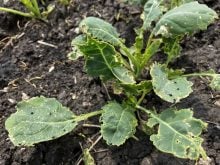BRANDON — It’s understandable to react with shock if you realize you’re blowing 10 percent or more of your canola crop out the back of the combine.
But that shouldn’t lead to a rushed overhaul of all the settings because it won’t reveal where the problem is coming from.
“You really only should be changing one setting at a time and then check out losses again,” Angela Brackenreed, an agronomist with the Canola Council of Canada, said at Manitoba Ag Days.
“You have no idea which one of those settings has either helped or hindered the process.”
Read Also

Growing garlic by the thousands in Manitoba
Grower holds a planting party day every fall as a crowd gathers to help put 28,000 plants, and sometimes more, into theground
Reducing harvest losses has been a focus of canola council agronomists for a few years, because many farmers don’t realize how much of their yield they’re leaving on the field.
Some farmers lose more than 10 percent, which is a huge and costly loss.
Brackenreed said in-field assessments and Prairie Agricultural Machinery Institute analysis suggest that farmers can reduce their losses to less than two percent, so that’s a goal every canola grower should have.
Many settings can affect the amount of seeds lost in the harvesting process, from the front of the combine to the back. The culprits need to be isolated. That can’t be done if multiple settings are changed after drop pans reveal a problem.
While a farmer might be shocked by how much he is losing now, the gains from fixing the situation are great. Brackenreed said a farmer going from a 10 percent loss to less than two percent loss will, at current values, earn $37.59 more per acre.
If a farmer grows 750 acres of canola, that works out to more than $28,000.
Brackenreed said farmers should aim to lose less than one bushel per acre, but those with high yields need to realize they are probably losing more than most farmers.
“We should think about this as a percentage of yield because we definitely see losses rise proportionately with yield.”

















